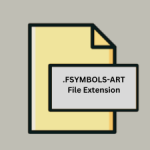.PSDB File Extension

PixelStyle Image
| Developer | Effectmatrix |
| Popularity | |
| Category | Raster Image Files |
| Format | .PSDB |
| Cross Platform | Update Soon |
What is an PSDB file?
PSDB is a file extension commonly associated with database files used in various software applications. These files store structured data in a tabular format, making them essential for managing and organizing information efficiently.
The PSDB file extension is not as widely recognized as some other database file formats, but it serves a specific purpose in certain software environments.
More Information.
The history and initial purpose of the PSDB file extension are closely tied to the software or platform where it is used.
Specific software applications or platforms that utilize PSDB files may have their own unique history and purpose for adopting this format. The history and initial purpose of PSDB files can vary depending on the context in which they are employed.
Origin Of This File.
The PSDB file format likely originated from the need for a proprietary or specialized database format in specific software applications.
It may have been developed by software developers or companies to create a database system that meets their specific requirements.
File Structure Technical Specification.
PSDB files typically follow a structured format that allows them to store data efficiently. While the exact technical specifications can vary between different software applications, some common elements include:
- Tabular data structure with rows and columns.
- Support for various data types (e.g., text, numbers, dates).
- Indexing and search capabilities to facilitate rapid data retrieval.
- Compatibility with SQL (Structured Query Language) for querying and managing data.
The specific technical details of PSDB files may vary, so referring to the documentation of the software or platform that generates or uses these files is essential for a complete understanding of their structure.
How to Convert the File?
Converting a PSDB file to another format or database system may be necessary to make it compatible with different software applications or platforms. The process for converting a PSDB file can vary depending on the target format or database system.
Below are instructions on how to convert a PSDB file on different operating systems and platforms:
Windows
- Use a Database Management Tool: Windows users can install a database management tool that supports PSDB files, such as Microsoft SQL Server Management Studio or MySQL Workbench.
- Import the PSDB File: Open the database management tool and create a new database or select an existing one. Then, use the tool’s import functionality to import the PSDB file. This process may involve specifying the source file, mapping columns, and configuring import options.
- Export to Desired Format: After importing the PSDB file, you can work with the data within the database management tool. To convert it to another format, you can use the tool’s export functionality to save the data in a different file format (e.g., CSV, SQL, Excel).
Linux
- Install a Database Management Tool: Linux users can install a database management tool that is compatible with PSDB files, such as MySQL or PostgreSQL.
- Access the Database: Open the database management tool and create a new database or use an existing one.
- Import the PSDB File: Use the tool’s import functionality to load the PSDB file into the database. This typically involves specifying the file path, mapping columns, and configuring import settings.
- Export to Desired Format: After importing the PSDB file, you can manipulate the data as needed within the database management tool. To convert it to another format, you can use the tool’s export features to save the data in a different file format.
Mac
- Install a Database Management Tool: Mac users can install a database management tool like MySQL Workbench or DBeaver.
- Create or Access a Database: Launch the database management tool, create a new database or select an existing one.
- Import the PSDB File: Use the tool’s import functionality to load the PSDB file into the database. Specify the file location, map columns, and configure import options.
- Export to Desired Format: Once the PSDB file is imported, manipulate the data within the database management tool. To convert it, use the tool’s export capabilities to save the data in the desired format (e.g., CSV, SQL).
Android
- Install a Mobile Database App: Android users can search for and install a mobile database app from the Google Play Store, such as SQLite Database Editor.
- Open the App: Launch the database app and create a new database or open an existing one.
- Import the PSDB File: Use the app’s import feature to load the PSDB file into the database. Specify the file location, map columns, and configure import settings.
- Export to Desired Format: After importing the PSDB file, work with the data within the app. To convert it to another format, if supported, use the app’s export feature to save the data in a different file format.
iOS
- Install a Mobile Database App: iOS users can search for and install a mobile database app from the App Store, such as DB Browser for SQLite.
- Open the App: Launch the database app and create a new database or open an existing one.
- Import the PSDB File: Use the app’s import functionality to load the PSDB file into the database. Specify the file location, map columns, and configure import options.
- Export to Desired Format: Once the PSDB file is imported, manipulate the data within the app. If the app supports it, use the export feature to save the data in the desired file format.
Advantages And Disadvantages.
Advantages
- Efficient Data Storage: PSDB files are designed to efficiently store structured data, making them suitable for applications that require data organization and retrieval.
- Customization: Developers can tailor the structure and functionality of PSDB files to suit the specific needs of their software.
- Compatibility: PSDB files may be compatible with SQL databases, facilitating data integration and manipulation.
Disadvantages
- Limited Recognition: PSDB files may not be as widely recognized as other database file formats, potentially causing compatibility issues when sharing data.
- Proprietary Nature: Some PSDB files may be proprietary and may not be easily accessible or transferable between different software applications.
- Learning Curve: Working with PSDB files may require a learning curve, as developers and users need to understand the specific structure and functionality of the format.
How to Open PSDB?
Open In Windows
- Use a compatible software application that supports PSDB files.
- Double-click the PSDB file, or open it from within the application.
Open In Linux
- Install a PSDB-compatible database management tool, if not already installed.
- Use the tool to open and manipulate PSDB files.
Open In MAC
- Similar to Linux, install a PSDB-compatible database management tool.
- Use the tool to open and work with PSDB files.
Open In Android
- Install a PSDB-compatible app from the Google Play Store.
- Use the app to browse and manage PSDB files on your Android device.
Open In IOS
- Install a PSDB-compatible app from the App Store.
- Use the app to access and interact with PSDB files on your iOS device.
Open in Others
For other operating systems or specialized environments, consult the documentation or support resources provided by the software or platform that generated the PSDB file. Specific instructions may vary depending on the context in which the file is used.













